When you hear “natural carpet cleaning,” what comes to mind? For many, it’s about ditching harsh chemicals for simple, non-toxic household staples like baking soda and vinegar. It’s a brilliant way to refresh your carpets, lift out stubborn odours, and deal with everyday stains, all without filling your home with questionable fumes.
Why Choose Natural Carpet Cleaning
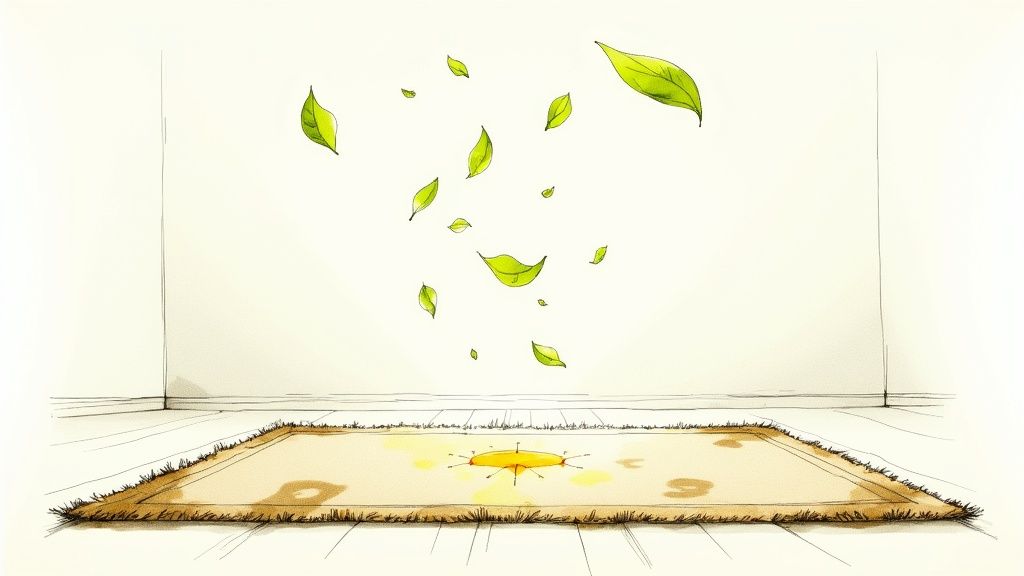
Making the move to natural carpet cleaning is about so much more than just getting the dirt out. It’s a conscious choice for a healthier, safer home. Think about it: traditional carpet cleaners are often packed with synthetic chemicals that can hang around long after you’ve finished, affecting your indoor air quality.
This is a big deal, especially if you have young children or pets. They’re the ones spending the most time playing, crawling, and napping on the floor, putting them in direct contact with any chemical residues. Shifting to natural alternatives completely removes that worry.
A Healthier Home Environment
The single biggest win with natural ingredients is the noticeable improvement in your home’s air quality. Many off-the-shelf cleaners release volatile organic compounds (VOCs), which have been linked to everything from respiratory issues and headaches to skin irritation.
By choosing natural methods, you’re taking a proactive step to shield your family from that unnecessary exposure. It’s a simple change that makes your living space not just look clean, but feel genuinely healthier. You can find more tips for creating a healthier home over on our Signal Cleaning blog.
Protecting Our Planet
The ripple effect of our cleaning choices goes far beyond our own four walls. Those chemicals in conventional products often get washed down the drain, making their way into our waterways and causing real harm to aquatic life.
Natural ingredients, however, are biodegradable and much kinder to the environment. When you use things like vinegar, baking soda, and salt, you can be confident you’re not adding to water pollution. It’s a small way to help preserve our local wildlife and natural resources.
This eco-conscious approach is part of a much bigger picture. The global demand for professional, green cleaning services is booming. The carpet cleaning market was valued at USD 7.5 billion in 2024 and is expected to more than double by 2033, with UK homeowners playing a huge part in driving this change.
Cost-Effective and Accessible
Let’s not forget the financial benefits. Natural carpet cleaning is incredibly kind to your wallet. The main ingredients are things you probably already have in your kitchen cupboards. A big bottle of white vinegar and a box of baking soda cost pennies compared to a single bottle of specialised carpet shampoo.
This accessibility is empowering. It means you can stay on top of regular cleaning and tackle spills as they happen without having to think about the cost. You get to maintain a beautiful home without relying on expensive, chemical-laden products, making clean living something everyone can achieve.
Gathering Your Eco-Friendly Cleaning Toolkit
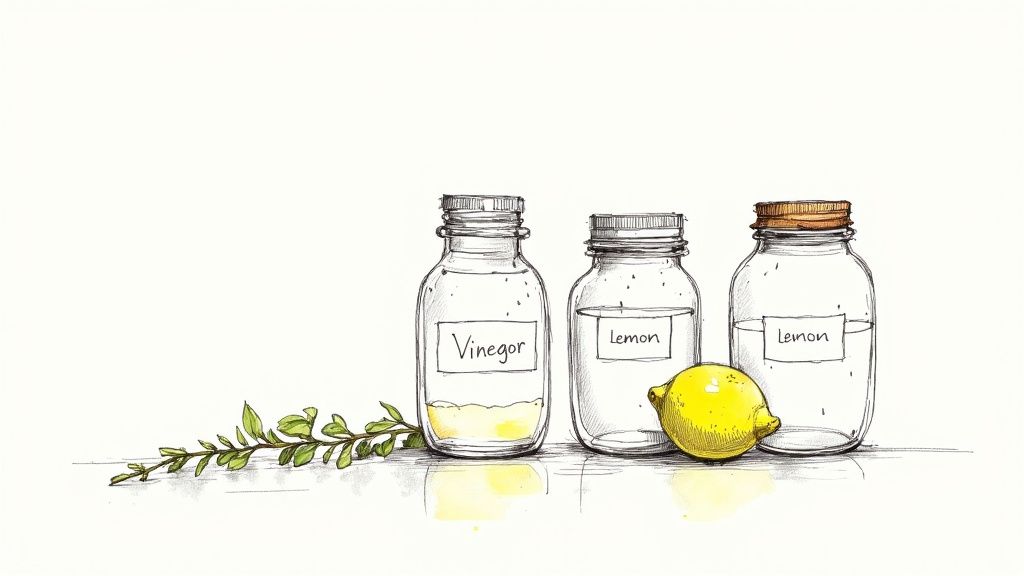
Before you can tackle any mess, you need the right supplies. Building an effective, all-natural cleaning arsenal is simpler and cheaper than you might think. In fact, most of the essentials for a proper natural carpet cleaning are probably already hiding in your kitchen cupboards.
That’s the real beauty of this approach. You don’t need a dozen specialised, chemical-laden products. A few powerful, multi-purpose ingredients are all it takes to handle everything from a general freshen-up to a sudden, dreaded spill. This isn’t just about cleaning; it’s about being prepared for life’s little accidents in a way that’s safe for your family and surprisingly effective.
Your Core Cleaning Ingredients
At the heart of any DIY cleaning kit are a few key players. Knowing what each one does is the first step to using them like a pro.
- Baking Soda (Bicarbonate of Soda): This is your ultimate deodoriser. Its alkaline nature is brilliant for neutralising acidic odours from things like pet urine or spilt milk, absorbing them directly from the carpet fibres.
- White Vinegar: Don’t let the smell fool you (it disappears as it dries!). The acetic acid in vinegar is a fantastic cleaning agent. It effortlessly cuts through grease and grime and acts as a mild disinfectant, all without leaving nasty residues behind.
- Table Salt: Never underestimate this humble seasoning. When you have a fresh spill—especially something like red wine—salt is your first line of defence. It works by drawing the liquid out of the carpet fibres before the stain has a chance to set.
- Essential Oils (Optional): If you want to add a pleasant scent, a few drops of lavender, lemon, or tea tree oil can be mixed into your cleaning solutions. They also offer some extra antibacterial muscle.
Before we move on to the tools, here’s a quick shopping list to help you get everything you need in one go.
Your Natural Carpet Cleaning Shopping List
This simple table breaks down the must-have items for your eco-friendly cleaning caddy.
| Item | Primary Use | Where to Find |
|---|---|---|
| Baking Soda | Deodorising, light scrubbing | Baking aisle in any supermarket |
| White Vinegar | Stain removal, disinfecting | Supermarket, usually with oils/condiments |
| Table Salt | Absorbing fresh liquid spills | Supermarket |
| Spray Bottles | Applying homemade solutions | Garden centre, hardware shop, or large supermarkets |
| Microfibre Cloths | Blotting and drying | Cleaning aisle in any supermarket |
| Stiff-bristled Brush | Working solution into tough stains | Hardware shop or cleaning aisle |
| Essential Oils | Adding fragrance, antibacterial boost | Health food shops, pharmacies, or online |
With these items on hand, you’re well-equipped to handle most common carpet cleaning tasks without reaching for harsh chemicals.
Essential Tools for the Job
Having the right ingredients is only half the battle; the right tools make all the difference. They ensure your cleaning is not only effective but also safe for your carpet.
One of the most common mistakes I see is people completely soaking their carpet with a cleaning solution. Remember, the goal is to clean the fibres, not the underlay. A good quality spray bottle that creates a fine, even mist is one of the most important tools you can own.
Your basic toolkit should start with a sturdy vacuum cleaner that has good suction. You’ll also need a couple of spray bottles for your homemade solutions and a stack of clean, absorbent microfibre cloths for blotting up stains and moisture.
A stiff-bristled brush can also be a lifesaver for working solutions into stubborn spots, but always be gentle! Scrubbing too hard can damage the carpet pile. I recommend keeping everything together in a caddy or bucket so it’s ready to grab the moment you need it.
Your Guide to a Deep Natural Clean
Right, let’s get our hands dirty. We’ve talked about the what and why of natural cleaning; now it’s time to put our simple, eco-friendly ingredients to work. Getting a truly deep clean is all about the right technique, not blasting your carpets with harsh chemicals.
Forget complicated routines. I’ll walk you through a straightforward process that actually works, from the prep work right through to the final rinse. We’ll cover the little details that prevent common mistakes, like soaking your carpet or leaving behind a sticky film that just attracts more dirt.
Laying the Groundwork with a Thorough Vacuum
Before you even think about mixing a cleaning solution, your vacuum cleaner is your best friend. And I don’t mean a quick whizz around the room. You need to be methodical here to pull up all the dry soil, dust, and pet hair that gets trodden deep into the fibres.
Think of that grit as tiny bits of sandpaper. Every time you walk on it, it grinds away at your carpet, dulling its colour and causing premature wear. For a really effective vacuum, slow right down. Go over the entire carpet in overlapping rows, first in one direction, and then do it all again at a 90-degree angle. This simple trick agitates the pile from all sides, lifting out stubborn debris that a single pass always misses.
Mixing and Applying Your Homemade Solution
With the loose dirt gone, it’s time for the cleaning solution. For a general, all-purpose clean, you can’t beat a simple mix of white vinegar and water. The acetic acid in the vinegar is fantastic at breaking down everyday grime without being harsh on your carpet.
- For a standard clean: Mix one part white vinegar with ten parts warm water in a spray bottle. It’s a gentle dilution that’s perfect for a regular refresh.
- For high-traffic areas: Up the concentration to one part white vinegar and five parts warm water. This gives you a bit more oomph for those well-trodden paths through the living room or down the hall.
Now, when you start spraying, remember the golden rule: less is more. You want to lightly mist the carpet, working in small, manageable sections. The aim is to dampen the fibres, not to soak the backing and underlay. Getting it too wet is a recipe for mould and mildew problems.
A classic mistake is drenching the carpet, thinking more solution equals a better clean. It doesn’t. It just makes it a nightmare to rinse and often leaves a residue that acts like a magnet for new dirt. A fine, even mist is all you need.
This visual breaks down the basic process into three simple parts.
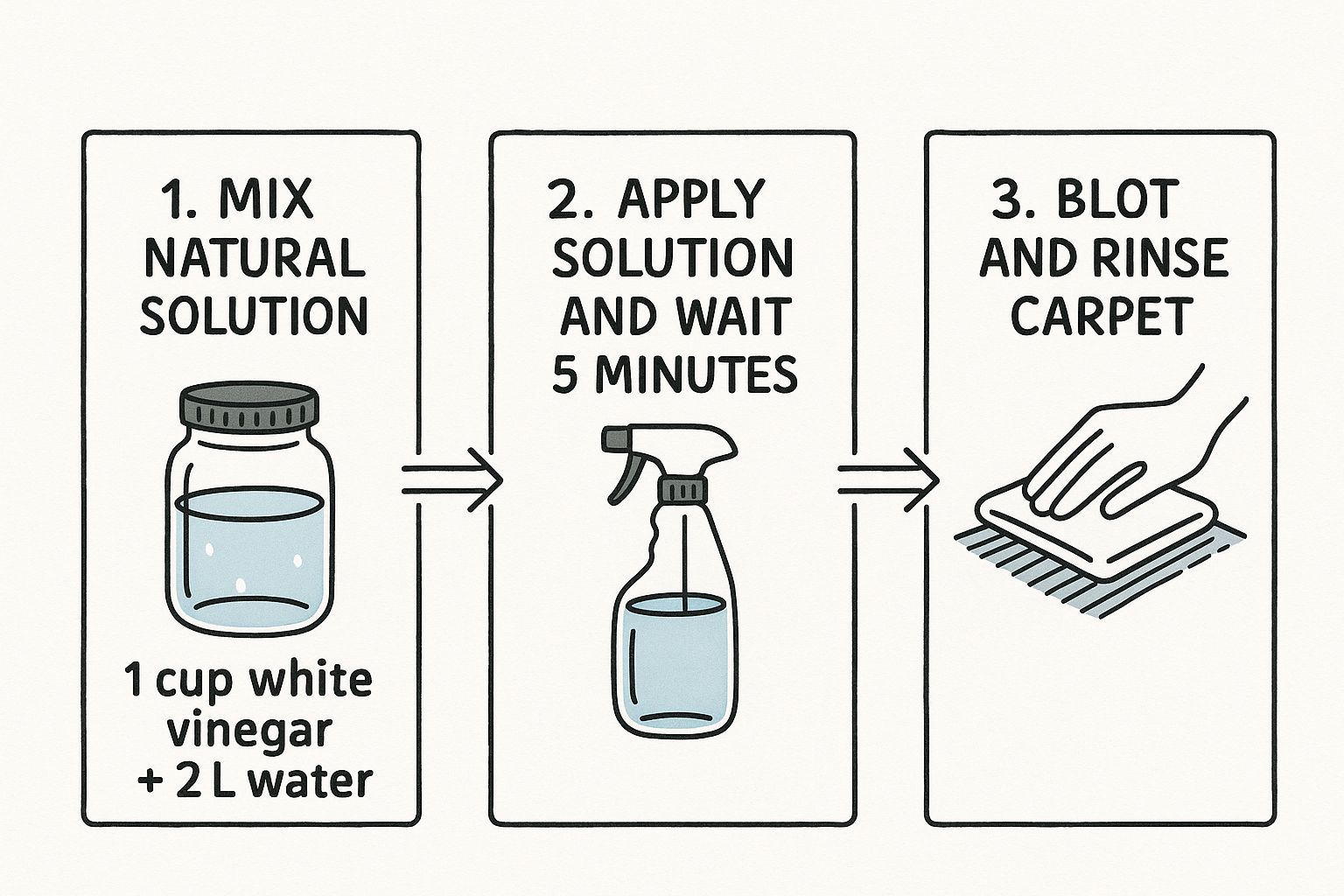
As you can see, a great result comes from a simple mix, a short dwell time, and proper blotting—no fancy machines or aggressive chemicals required.
The Art of Agitation and Rinsing
Once you’ve misted a section, let the solution sit for about five to ten minutes. This “dwell time” is crucial. It gives the vinegar a chance to get to work, breaking down the oils and dirt clinging to the fibres.
Next, you’ll want to gently agitate the area with a soft-bristled brush. I find small, circular motions work best. The key here is gentle—you’re not trying to scrub a stain off a patio. You’re just helping the solution work its way in and loosen the grime. Scrubbing too hard can fray the carpet pile.
Finally, the rinse. This is the step that guarantees you won’t be left with a sticky residue. Grab a new spray bottle filled with plain, clean water and lightly mist the area you just cleaned. Straight away, take a clean, dry microfibre cloth and blot the area firmly. Press down hard to soak up the moisture and the dirt with it. Keep blotting with a fresh part of the cloth until it comes up clean, then you’re ready to move on to the next section.
Tackling Tough Stains the Natural Way
Let’s face it, spills happen. That heart-sinking moment when red wine splashes onto your cream carpet or muddy paws leave a trail doesn’t have to mean reaching for harsh chemicals. The good news is your kitchen cupboards are likely already stocked with everything you need to tackle almost any stain emergency.
The trick to successful natural carpet cleaning is to act fast and tailor your approach to the type of spill. Above all, remember the golden rule of stain removal: always blot, never rub. Rubbing just grinds the stain deeper into the carpet fibres and can even damage them, making a bad situation much worse.
Your Go-To Recipes for Common Stains
Different messes call for different measures. You wouldn’t treat a greasy pizza mark the same way you’d tackle a coffee spill. Here are a few battle-tested recipes for some of the most common culprits I’ve seen over the years.
- Red Wine and Coffee Spills: As soon as the spill happens, grab a clean cloth and blot up as much of the liquid as you can. Then, pour a generous amount of table salt or baking soda directly onto the stain to draw out the remaining moisture. Let it sit for a few hours, or until completely dry, then just vacuum it up.
- Greasy Food Stains: For oily marks from things like butter, pizza, or salad dressing, your first step is to sprinkle cornflour or baking soda all over it. This works wonders to absorb the grease. Give it at least 15 minutes to work its magic before you vacuum it away.
- Pet Accidents: To deal with both the stain and the lingering odour, start by blotting the area thoroughly. Next, spray it with a simple solution of equal parts white vinegar and water. While the spot is still damp, sprinkle a good layer of baking soda over the top. You’ll see it start to fizz – that’s the cleaning power in action! Let it dry completely, then vacuum.
For those extra-tricky spots, our guide on how to remove stubborn stains has some more advanced tips.
Before you go all-in on a visible stain, always do a quick patch test. Find a hidden spot, like under the sofa or in a corner, and apply a small amount of your cleaning mixture. This simple check ensures the solution won’t cause any discolouration on your carpet.
The Science Behind the Simplicity
These natural remedies aren’t just old wives’ tales; their effectiveness is rooted in simple chemistry. That fizzing you see when vinegar (an acid) meets baking soda (an alkali) is carbon dioxide gas being released. This reaction helps to lift dirt and neutralise odours from deep within the carpet pile. Salt, with its crystalline structure, is brilliant at absorbing liquids through osmosis.
Understanding why these ingredients work makes you much more confident in tackling messes yourself. It’s this growing awareness of safer, effective cleaning that’s changing the professional industry, too. The UK’s carpet and upholstery cleaning market was valued at around £3.1 billion in 2022, and carpet services accounted for almost 73% of that.
Experts predict this sector will grow to nearly £4.7 billion by 2030, driven largely by people wanting healthier, more hygienic homes. It’s clear that a fresh, clean living space is more important than ever.
Keeping Your Carpets Fresh Between Cleans
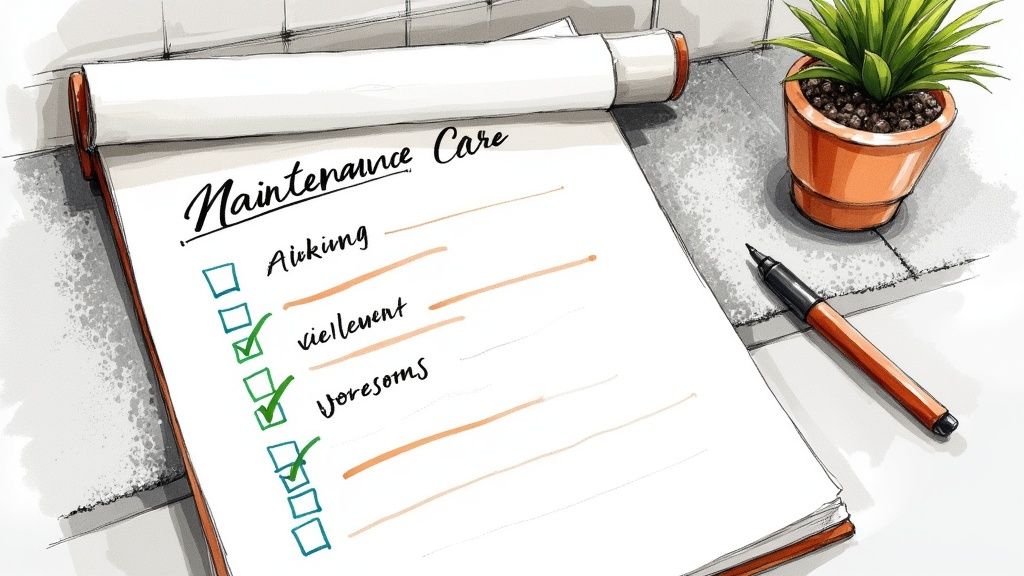
A deep, natural clean can work wonders, but the real secret to keeping that just-cleaned feeling is what you do in the days and weeks that follow. Consistent, simple habits make all the difference, preventing dirt and odours from getting a foothold in the first place.
Think of it as proactive care. These small routines drastically cut down on how often you need to do a full-on deep clean, keeping your carpets looking and feeling fantastic for much longer. It’s a low-effort, high-reward strategy for maintaining your home.
It’s no surprise that people value a pristine living space. The UK cleaning industry was valued at roughly £59.8 billion in 2021, and the number of cleaning businesses shot up to over 75,500 by 2023. These UK cleaning industry statistics show a clear trend: we’re all looking for ways to keep our homes beautifully clean, whether through our own efforts or with expert help.
Smart Daily Habits for Fresher Carpets
Often, the most effective defence is the simplest one. A good-quality doormat at every entrance is a must-have. It’s your front line, catching the worst of the mud, grit, and moisture before it even has a chance to get trampled into your carpets.
Another game-changer is having a “shoes off at the door” rule. It might feel like a small thing, but it’s one of the best ways to protect your carpet fibres from the abrasive dirt and pollutants we bring in from outside.
And, of course, there’s the vacuum cleaner. Regular vacuuming—at least twice a week for hallways and living rooms—is non-negotiable. It lifts all that surface-level dust and debris before it has time to get ground deep into the pile.
A Simple DIY Carpet Deodoriser
For a quick refresh that leaves your room smelling wonderful, you can whip up your own natural carpet deodoriser in minutes. It’s incredibly easy and a much healthier alternative to chemical-laden air fresheners.
Here’s how you do it:
- Get your supplies: Grab a clean jar, about 200g of bicarbonate of soda (baking soda), and 10-15 drops of your preferred essential oil. Lavender, lemon, and peppermint are all brilliant choices for a fresh scent.
- Mix it all together: Pop the bicarb and essential oils into the jar, screw on the lid, and give it a really good shake to distribute the oil evenly.
- Sprinkle and wait: Lightly scatter the scented powder over your carpets. You don’t need a thick layer. Leave it to work its magic for at least 15-30 minutes—this gives the bicarb time to absorb any musty smells.
- Vacuum it up: Run the vacuum over the area thoroughly to suck up all the powder. You’ll be left with a lovely, subtle fragrance.
This simple trick does more than just cover up smells. Bicarbonate of soda actively neutralises the acidic molecules that cause odours, leaving your carpet genuinely fresher.
These little habits are perfect for day-to-day upkeep. But for those times when your carpets need a truly professional revival, you can always book a convenient cleaning service online to get them back to their absolute best.
Got Questions About Natural Carpet Cleaning? Let’s Clear Things Up
It’s only natural to have a few questions when you’re about to ditch the harsh chemical cleaners you’ve used for years. I get it. Making the switch to natural carpet cleaning is a fantastic decision, but it’s wise to go in with your eyes open. Let’s walk through some of the most common things people ask me.
First up, the big one: “Will my house smell like a chip shop?” A very valid question! White vinegar definitely has a strong, sharp scent when you first apply it. But here’s the good news—that smell completely vanishes as it dries. Once your carpet is dry to the touch, all you’ll be left with is a fresh, neutral scent. If you want a bit of fragrance while you work, just add a few drops of your favourite essential oil, like lavender or lemon, to the mix.
Another common worry is whether these homemade solutions are actually powerful enough to do the job. We’ve been conditioned to think that a strong chemical smell equals a deep clean. In reality, ingredients like vinegar and bicarbonate of soda are cleaning powerhouses. They work through simple but effective chemical reactions—the acid in vinegar breaks down dirt and stains, while the alkaline nature of bicarb is brilliant for neutralising stubborn odours. No harsh synthetics needed.
Are These Methods Safe for All Carpet Types?
This is a really important point, especially if you’ve invested in delicate wool rugs or natural fibre carpets. The gentle solutions we’ve covered are perfectly safe for most common synthetic carpets, like nylon and polyester. With natural fibres, however, you need to be a bit more careful.
- Wool Carpets: Wool is sensitive to anything too alkaline (like bicarb) and doesn’t respond well to high heat. Using bicarbonate of soda can lead to yellowing over time. A heavily diluted white vinegar and water solution is generally okay, but you absolutely must test it first.
- Sisal or Jute: These plant-based carpets are like sponges and can get water stains very easily. For these, it’s best to stick to dry cleaning methods. Using a powder like bicarbonate of soda to absorb dirt and odours is a much safer approach. Steer clear of wet cleaning entirely.
Always, always do a patch test before you start. Find a hidden spot, maybe under the sofa or in a closet, apply a tiny amount of your cleaning mixture, and let it dry completely. This one simple check can prevent a whole lot of heartache.
How Often Should I Be Deep Cleaning My Carpets?
For the average home, giving your carpets a deep natural carpet cleaning every 12 to 18 months is a good rule of thumb. Of course, your home isn’t “average.” If you’ve got pets, small children, or anyone with allergies, you’ll probably want to do it more often, perhaps every six months.
The real key to keeping your carpets looking great is consistent maintenance. Regular vacuuming and tackling spills the moment they happen will make the biggest difference. The deep clean is for getting rid of that deep-seated grime that a quick vacuum just can’t touch, ensuring your home stays healthy and your carpets last for years.
When life gets too busy for DIY, Signal Cleaning offers professional, high-quality cleaning services to get your home looking its absolute best. Book your cleaning service online today
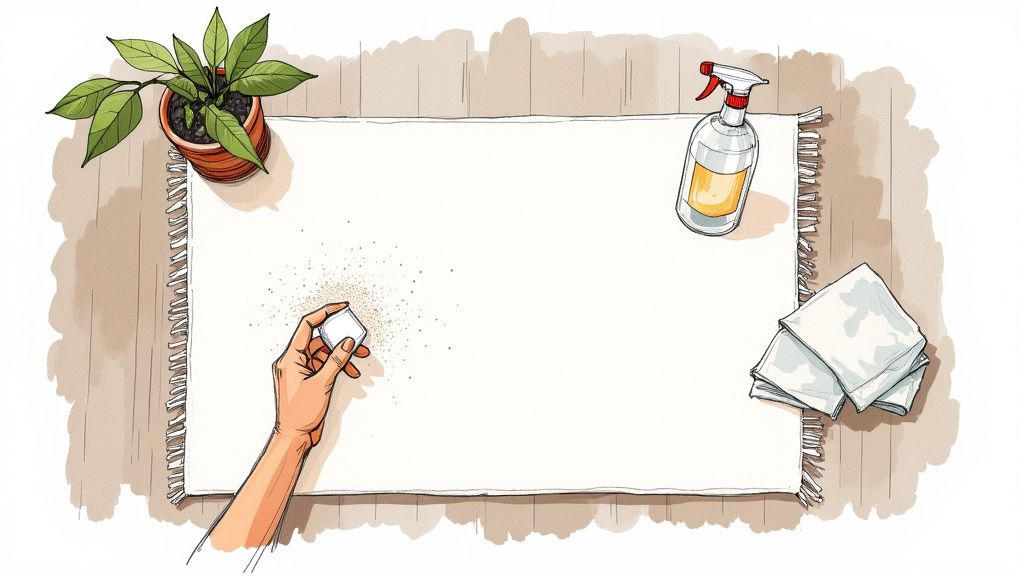
Leave a Reply